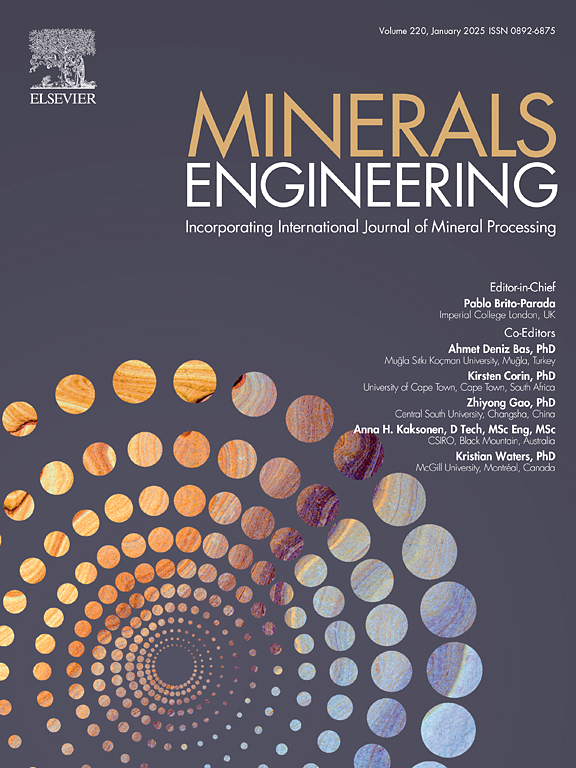High pressure dewatering rolls Mark-II: A novel dewatering technology for mineral tailings
IF 5
2区 工程技术
Q1 ENGINEERING, CHEMICAL
引用次数: 0
Abstract
High Pressure Dewatering Rolls (HPDR) is a continuous, high pressure, cloth-less filter designed to improve solid–liquid separation. The Mark-I prototype demonstrated cake solid concentrations comparable to those of conventional filter presses during trials with various industrial suspensions. A further development (HPDR Mk-II) is described here. It is designed for mineral tailings, features a larger filtration area, improved handling of fine particles using 30 µm wedge wires as the filter surface, and the potential for cost reductions in achieving low moisture content.
This study overviews the design, proof of concept (phase 1) and safe and continuous steady state operation (phase 2) of the device. Phase 1 demonstrated operation using both flocculated and non-flocculated copper tailings (D[3,2] = 5.84 µm) and phase 2 showcases operation in runs up to one hour with nickel tailings (D[3,2] = 9.33 µm) under varying conditions. Thorough material characterisation of the tailings was conducted for benchmarking purposes. The HPDR achieved filter cake moisture contents of 83.1 wt% for copper and 87.9 wt% for nickel tailings, with a maximum specific solids throughput of 302 kg/m2.hr for nickel and 73 kg/m2.hr for copper. The cake moisture and specific throughput were comparable to or better than filter press performance, but with the advantages of continuous, cloth-less operation.
高压脱水辊Mark-II:一种新型的尾矿脱水技术
高压脱水辊(HPDR)是一种连续,高压,无布过滤器,旨在提高固液分离。在各种工业悬浮液的试验中,Mark-I原型机展示了与传统压滤机相当的饼固体浓度。这里描述了进一步的发展(HPDR Mk-II)。它专为矿物尾矿设计,具有更大的过滤面积,使用30µm楔形线作为过滤表面改善了对细颗粒的处理,并且在实现低水分含量方面具有降低成本的潜力。本研究概述了该设备的设计、概念验证(第一阶段)和安全连续稳态运行(第二阶段)。第一阶段演示了使用絮凝和非絮凝铜尾矿(D[3,2] = 5.84µm)的操作,第二阶段展示了在不同条件下使用镍尾矿(D[3,2] = 9.33µm)运行长达一小时的操作。对尾矿进行了全面的材料表征,以达到基准目的。HPDR滤饼中铜的含水率为83.1 wt%,镍的含水率为87.9%,最大比固体吞吐量为302 kg/m2。镍为Hr, 73 kg/m2。Hr代表铜。滤饼含水率和比吞吐量与压滤机性能相当或优于压滤机,但具有连续、无布操作的优点。
本文章由计算机程序翻译,如有差异,请以英文原文为准。
求助全文
约1分钟内获得全文
求助全文
来源期刊

Minerals Engineering
工程技术-工程:化工
CiteScore
8.70
自引率
18.80%
发文量
519
审稿时长
81 days
期刊介绍:
The purpose of the journal is to provide for the rapid publication of topical papers featuring the latest developments in the allied fields of mineral processing and extractive metallurgy. Its wide ranging coverage of research and practical (operating) topics includes physical separation methods, such as comminution, flotation concentration and dewatering, chemical methods such as bio-, hydro-, and electro-metallurgy, analytical techniques, process control, simulation and instrumentation, and mineralogical aspects of processing. Environmental issues, particularly those pertaining to sustainable development, will also be strongly covered.
 求助内容:
求助内容: 应助结果提醒方式:
应助结果提醒方式:


